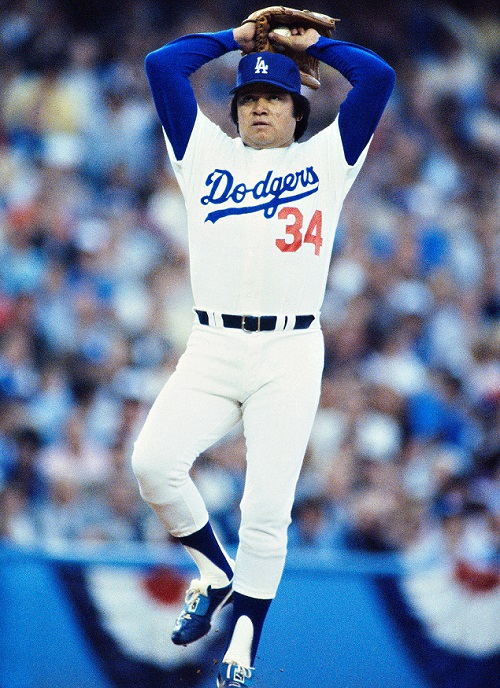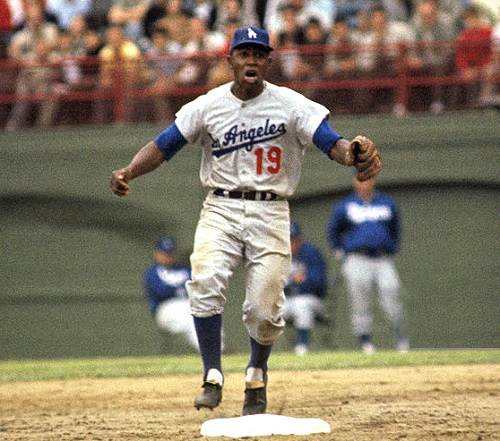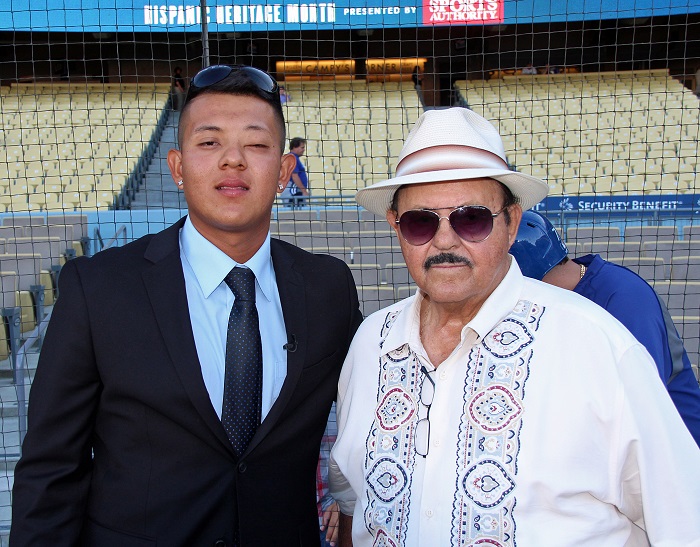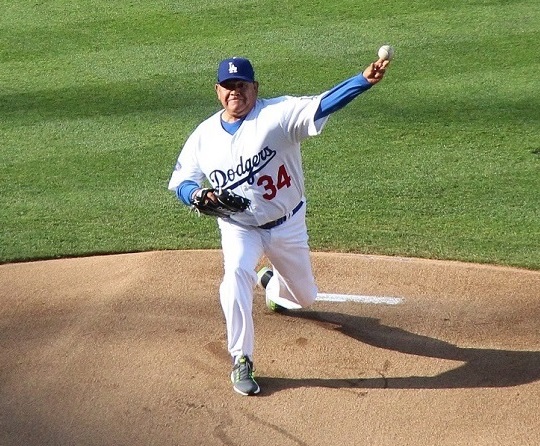It goes without saying that baseball uniform number 42 is the most sacred and revered uniform number not only in Dodgers history but in baseball history. It is, of course, the uniform number worn by the great Jackie Robinson who, in 1947, broke baseball’s color barrier. It is also the only uniform number retired by every team in Major League Baseball.
But there is another Dodgers uniform number that most Dodger fans hold near and dear to their hearts. And while it may not carry the same historical significance that Robinson’s number 42 does, it is every bit as important in bringing racial equality to the game. That uniform number is, of course, number 34, worn by Navojoa, Sonora, Mexico native and Dodger great Fernando Valenzuela.
As most Dodger fans know, Fernando (as he will forever be known by a single name – much like Ichiro) made his first MLB start on Opening Day 1981 as an emergency replacement starter for another Dodgers left-hander – Jerry Reuss – who had injured his right calf shagging batting practice fly balls not 24-hours before Opening Day. And while Dodgers manager Tommy Lasorda would have preferred to replace Reuss with veteran right-handers Burt Hooton or Bob Welch, they, too, were nursing injuries – Hooton with an ingrown toenail and Welch with a sore right elbow. Lasorda couldn’t use right-handers Dave Goltz or Rick Sutcliffe because they had both pitched in the just-concluded annual pre-season Freeway Series against the Angels. This left Lasorda with exactly one option – 20-year-old rookie left-hander Fernando Valenzuela, who had exactly 17.2 innings of major league experience after his brief September 1, 1980 call-up – none as a starter.
Fernando not only won on Opening Day 1981, he went on to win his first eight starts – five by shutouts – and overnight Fernandomania was born.
“Everywhere he pitched stadiums were packed and people came from other cities when Fernando was going to pitch when the Dodgers were playing [on the road],” said legendary Dodgers scout Mike Brito, who had signed Fernando as an 18-year-old out of the Liga Mexicana de Beisbol (Mexican Baseball League). “I don’t think that is ever going to happen again.”
Fernando would finish the strike-shortened 1981 season with a 13-7 record and a 2.48 ERA – good enough to win the NL Cy Young award, the NL Rookie of the Year award, a Silver Slugger award and a trip to the 1981 All-Star Game. But more importantly, he helped unify a racially diverse city with a very large Hispanic population and, as noted by Brito, was a huge draw nationwide wherever he pitched.

Fernando capped off his brilliant 1981 rookie season by winning Game-3 of the World Series after the Dodgers had lost the first two games to the Yankees in New York. It was the turning point of the series which the Dodgers ultimately won in six games. (Getty Images)
Fernando remained with the Dodgers for 11 seasons compiling a 141-116 record and 3.31 ERA. He went on to pitch three seasons with the San Diego Padres and one each with the Angels, Phillies, Cardinals and Orioles before retiring in 1997 with a career mark of 173-153 and 3.54 ERA.
In 2003, Fernando rejoined the Dodgers as a member of their Spanish broadcast team joining Hall of Famer Jaime Jarrín and Pepe Yñiguez, a position which he still holds today. And without exception, every time he is shown on the Dodger Stadium jumbotron (now called video boards), he receives a tremendous ovation. Simply put, his is one of the most beloved and recognizable figures in LA sports history.
So why, then, haven’t the Dodgers retired Fernando’s number? The answer to this is actually quite simple, although unquestionably unpopular among Dodger fans.
Unlike many MLB teams – most, in fact – the Dodgers have a self-imposed policy that the only way to have a uniform number retired is to be voted into the National Baseball Hall of Fame – period. But while there are seven former Dodgers players and two former Dodgers managers enshrined in the sacred Halls of Cooperstown, there is one who is not – former Dodgers infielder/outfielder Jim “Junior” Gilliam.
The Nashville, TN native and Negro Leagues standout spent his entire 14-year MLB career with the Brooklyn and Los Angeles Dodgers from 1953 through 1966 and served as a coach with the team until his sudden and tragic death on October 8, 1978 from a massive brain hemorrhage nine days before his 50th birthday. Two days later and perhaps more out of grief and emotion than anything else, Dodgers owner Peter O’Malley retired Gilliam’s number just prior to Game-1 of the 1978 World Series.
“He didn’t hit with power, he had no arm, and he couldn’t run, but he did the little things to win ballgames,” said Hall of Fame Dodgers manager Walter Alston, for whom Gilliam played his entire career under. “He never griped or complained. He was one of the most unselfish ballplayers I know.”

Although Gilliam was a four-time World Series champion, he had a career .265 batting average. (Photo credit – Neil Leifer)
There is absolutely zero argument whatsoever that Pee Wee Reese (1), Tommy Lasorda (2), Duke Snider (4), Don Sutton (20), Walter Alston (24), Sandy Koufax (32), Roy Campanella (39), Jackie Robinson (42) and Don Drysdale (53) all belong in the Hall of Fame. But there is argument that if non-Hall of Famer Jim Gilliam had his uniform number (19) retired, then so, too, should Fernando. And while neither Gilliam nor Fernando put up Hall of Fame-worthy numbers, both were instrumental in the Dodgers winning World Series titles in 1955, 1959, 1963 and 1965 for Gilliam and 1981 for Fernando.
All of this being said, uniform number 34 has not been worn by another Dodger player since the now 54-year-old Fernando left the team in 1990. In fact, number 34 is the only number that hasn’t been reissued – excluding those that have been retired or the higher uniform numbers that have rarely or never been worn before. And you can thank one man for this – longtime Dodgers clubhouse manager Mitch Poole, whose job it is (among countless others) to assign uniform numbers.
Enter 18-year-old Mexican phenom left-hander Julio Urias, yet another Mike Brito signing.

It’s no coincidence that Mike Brito, the man who discovered Fernando Valenzuela, also discovered Yasiel Puig and Julio Urias. (Photo credit – Ron Cervenka)
It has long been speculated by Dodger fans and the media that Urias will be a September 1 call-up this season. It has also been speculated that when that day comes, he will be the first to wear number 34 since Fernando. But while this would undoubtedly meet with Fernando’s approval and blessings, it’s not going to happen.
“He’s already told us what number he wants but I can’t really specify,” said Poole this past Saturday. “He’s already been assigned a number because he asked for it and it was available, and it’s not 34.”
Does Poole expect Urias to be called up this season?
“It’s hard to say since I’m not the general manager,” he said jokingly. “But we’re ready for him if he does, let’s put it that way. You have to get things in order like what kind of bats he likes and whatever, so we’ve already done a bit of ground work looking into what he likes before he gets here.”
That takes us back to uniform number 34, which was the second choice of Manny Ramirez when he was acquired by the Dodgers at the July 31, 2008 non-waiver trade deadline. (His first choice was 24 which, of course, had already been retired).
“What about 34?” Manny asked Poole when he arrived in the Dodgers clubhouse on August 1, 2008.
“Well… it’s not retired, but… Fernando… I can’t… we can’t do that,” Poole tactfully explained to Ramirez. “Fernando has always had that number and nobody else has worn it since.”
“Yeah, but it’s not a retired number,” Ramirez argued.
“In our hearts it is,” explained Poole.
Ramirez eventually agreed on number 99 – a decision that brought in tremendous profits for the Dodgers (and Ramirez) in jersey and T-shirt sales.

The only guy who has worn number 34 since Fernando retired is Fernando himself, seen here during an Old-Timers Game at Dodger Stadium. (Photo credit – Ron Cervenka)
So number 34 – Fernando Valenzuela’s unofficially retired number – still remains the only number that hasn’t been reissued even 25 years later.
“Number 34 is pretty much it until somebody in that room in there steps up and makes it so you can’t use their number anymore,” said Poole. “But there’s one potential one if you think about it, our ace actually. Someday.”
Will the Dodgers ever officially retire Fernando’s number?
“I can’t answer whether Fernando’s number will ever be retired,” said Poole. “But I won’t be the one to give it out – not unless I am told I have to.”
Well played, Mitch. Well played indeed.




 July 16th, 2015 at 6:00 am
July 16th, 2015 at 6:00 am  by Ron Cervenka
by Ron Cervenka  Posted in
Posted in 

Great article. FV made his first MLB start on opening day 1981, but it was not his MLB debut (1980).
It’s amazing how strict the Dodgers are when it comes to retiring numbers but it doesn’t seem like the Yankees are worrying about running out of available numbers.
How about some love for Gil Hodges #14? He belongs in the HOF, so far denied. Hopefully veteran’s committee will put him in some day.
Absolutely!
I fear that, as time goes on, even the members of the Veterans Committee will be too young to remember just how great Gil Hodges was.
I just hope it happens before I… well… you know.
Now that Harper is around the corner….if he wants 34 will La give it to him?